Hox gene control of segment-specific bristle patterns in Drosophila
- PMID: 12000797
- PMCID: PMC186253
- DOI: 10.1101/gad.219302
Hox gene control of segment-specific bristle patterns in Drosophila
Abstract
Hox genes specify the different morphologies of segments along the anteroposterior axis of animals. How they control complex segment morphologies is not well understood. We have studied how the Hox gene Ultrabithorax (Ubx) controls specific differences between the bristle patterns of the second and third thoracic segments (T2 and T3) of Drosophila melanogaster. We find that Ubx blocks the development of two particular bristles on T3 at different points in sensory organ development. For the apical bristle, a precursor is singled out and undergoes a first division in both the second and third legs, but in the third leg further differentiation of the second-order precursors is blocked. For the posterior sternopleural bristle, development on T3 ceases after proneural cluster initiation. Analysis of the temporal requirement for Ubx shows that in both cases Ubx function is required shortly before bristle development is blocked. We suggest that interactions between Ubx and the bristle patterning hierarchy have evolved independently on many occasions, affecting different molecular steps. The effects of Ubx on bristle development are highly dependent on the context of other patterning information. Suppression of bristle development or changes in bristle morphology in response to endogenous and ectopic Ubx expression are limited to bristles at specific locations.
Figures
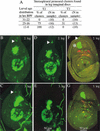


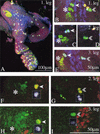
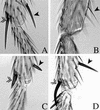
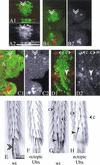
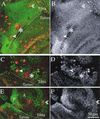

Similar articles
-
Differential Delta expression underlies the diversity of sensory organ patterns among the legs of the Drosophila adult.Mech Dev. 2007 Jan;124(1):43-58. doi: 10.1016/j.mod.2006.09.004. Epub 2006 Sep 30. Mech Dev. 2007. PMID: 17107776
-
The function and regulation of Ultrabithorax in the legs of Drosophila melanogaster.Dev Biol. 2007 Aug 15;308(2):621-31. doi: 10.1016/j.ydbio.2007.06.002. Epub 2007 Jun 12. Dev Biol. 2007. PMID: 17640629 Free PMC article.
-
A Distalless-responsive enhancer of the Hox gene Sex combs reduced is required for segment- and sex-specific sensory organ development in Drosophila.PLoS Genet. 2018 Apr 10;14(4):e1007320. doi: 10.1371/journal.pgen.1007320. eCollection 2018 Apr. PLoS Genet. 2018. PMID: 29634724 Free PMC article.
-
Morphogenesis of Drosophila melanogaster macrochaetes: cell fate determination for bristle organ.J Stem Cells. 2012;7(1):19-41. J Stem Cells. 2012. PMID: 23550342 Review.
-
Roles for intrinsic disorder and fuzziness in generating context-specific function in Ultrabithorax, a Hox transcription factor.Adv Exp Med Biol. 2012;725:86-105. doi: 10.1007/978-1-4614-0659-4_6. Adv Exp Med Biol. 2012. PMID: 22399320 Review.
Cited by
-
Control of tissue morphogenesis by the HOX gene Ultrabithorax.Development. 2020 Mar 2;147(5):dev184564. doi: 10.1242/dev.184564. Development. 2020. PMID: 32122911 Free PMC article.
-
Michael Akam and the rise of evolutionary developmental biology.Int J Dev Biol. 2010;54(4):561-5. doi: 10.1387/ijdb.092908ds. Int J Dev Biol. 2010. PMID: 20209429 Free PMC article.
-
Segment-specific regulation of the Drosophila AP-2 gene during leg and antennal development.Dev Biol. 2011 Jul 15;355(2):336-48. doi: 10.1016/j.ydbio.2011.04.032. Epub 2011 May 7. Dev Biol. 2011. PMID: 21575621 Free PMC article.
-
Stage-specific control of stem cell niche architecture in the Drosophila testis by the posterior Hox gene Abd-B.Comput Struct Biotechnol J. 2015 Jan 21;13:122-30. doi: 10.1016/j.csbj.2015.01.001. eCollection 2015. Comput Struct Biotechnol J. 2015. PMID: 25750700 Free PMC article. Review.
-
Hox genes mediate the escalation of sexually antagonistic traits in water striders.Biol Lett. 2019 Feb 28;15(2):20180720. doi: 10.1098/rsbl.2018.0720. Biol Lett. 2019. PMID: 30958129 Free PMC article.
References
-
- Abu-Shaar M, Mann RS. Generation of multiple antagonistic domains along the proximodistal axis during Drosophila leg development. Development. 1998;125:3821–3830. - PubMed
-
- Akam M. The molecular basis for metameric pattern in the Drosophila embryo. Development. 1987;101:1–22. - PubMed
-
- Auerbach C. The development of the legs, wings, and halteres in wild type and some mutant strains of Drosophila melanogaster. Proc R Soc Edinb B. 1936;58:787–815.
-
- Blochlinger K, Bodmer R, Jan LY, Jan YN. Patterns of expression of Cut, a protein required for external sensory organ development in wild-type and cut mutant Drosophila embryos. Genes & Dev. 1990;4:1322–1331. - PubMed
Publication types
MeSH terms
Substances
Grants and funding
LinkOut - more resources
Full Text Sources
Other Literature Sources
Molecular Biology Databases
